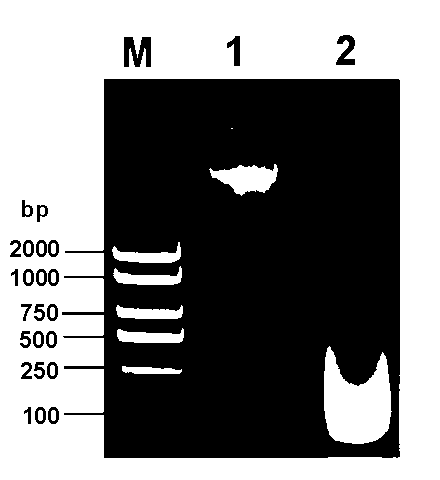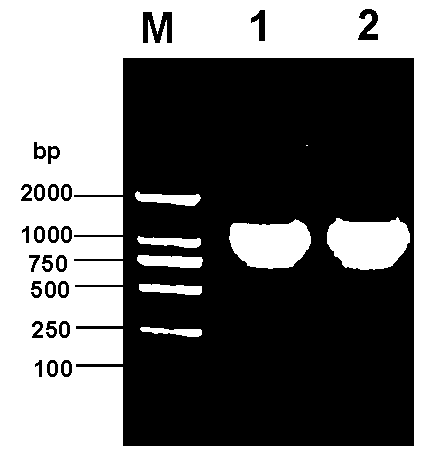Method for extracting genomic DNA from giant salamander skin mucus
A genome and body surface technology, applied in the field of bioengineering, can solve problems such as violation of protection, numerous operation steps, experimental operators and environmental hazards, and achieve the effect of convenient preservation
- Summary
- Abstract
- Description
- Claims
- Application Information
AI Technical Summary
Problems solved by technology
Method used
Image
Examples
Embodiment 1
[0025] 1. Preparation of lysate
[0026] Mix 160 microliters of 1 mol / L sodium chloride (NaCl) aqueous solution, 40 microliters of 100 mmol / L tris-hydrochloride (Tris–HCl) aqueous solution with a pH value of 8.0, and 2 microliters of 100 mmol / L L with a pH of 8.0 ethylenediaminetetraacetic acid disodium (EDTANa 2 ) aqueous solution at room temperature, then add 160 microliters of 10% sodium dodecyl sulfate (SDS) aqueous solution and 20 microliters of proteinase K aqueous solution with a concentration of 10 mg / mL, and mix rapidly to prepare into the desired lysate.
[0027] 2. Preserve the samples: Collect giant salamander body surface mucus or body surface peeling skin from the body surface of giant salamander without trauma, put the collected mucus or body surface peeling skin in 90% ethanol for dehydration, and store it at room temperature. Press down and save for later use;
[0028] 3. Ethanol replacement: Take out the mucus or peeled skin obtained in step 2, put it in a...
example 2
[0035] 1. Preparation of lysate
[0036] Mix 160 microliters of 1 mol / L sodium chloride (NaCl) aqueous solution, 40 microliters of 100 mmol / L tris-hydrochloride (Tris–HCl) aqueous solution with a pH value of 8.0, and 2 microliters of 100 mmol / L L with a pH of 8.0 ethylenediaminetetraacetic acid disodium (EDTANa 2 ) aqueous solution at room temperature, then add 160 microliters of 10% sodium dodecyl sulfate (SDS) aqueous solution and 20 microliters of proteinase K aqueous solution with a concentration of 10 mg / mL, and mix rapidly to prepare into the desired lysate.
[0037] 2. Preserve the samples: Collect giant salamander body surface mucus or body surface peeling skin from the body surface of giant salamander without trauma, put the collected mucus or body surface peeling skin in 90% ethanol for dehydration, and store it at room temperature. Press down and save for later use;
[0038] 3. Ethanol replacement: Take out the mucus or peeled skin obtained in step 2, put it in a...
Embodiment 3
[0045] 1. Preparation of lysate
[0046] Mix 160 microliters of 1 mol / L sodium chloride (NaCl) aqueous solution, 40 microliters of 100 mmol / L tris-hydrochloride (Tris–HCl) aqueous solution with a pH value of 8.0, and 2 microliters of 100 mmol / L L with a pH of 8.0 ethylenediaminetetraacetic acid disodium (EDTANa 2 ) aqueous solution at room temperature, then add 160 microliters of 10% sodium dodecyl sulfate (SDS) aqueous solution and 20 microliters of proteinase K aqueous solution with a concentration of 10 mg / mL, and mix rapidly to prepare into the desired lysate.
[0047] 2. Preserve the samples: Collect giant salamander body surface mucus or body surface peeling skin from the body surface of giant salamander without trauma, put the collected mucus or body surface peeling skin in 90% ethanol for dehydration, and store it at room temperature. Press down and save for later use;
[0048] 3. Ethanol replacement: Take out the mucus or peeled skin obtained in step 2, put it in a...
PUM
 Login to View More
Login to View More Abstract
Description
Claims
Application Information
 Login to View More
Login to View More - R&D
- Intellectual Property
- Life Sciences
- Materials
- Tech Scout
- Unparalleled Data Quality
- Higher Quality Content
- 60% Fewer Hallucinations
Browse by: Latest US Patents, China's latest patents, Technical Efficacy Thesaurus, Application Domain, Technology Topic, Popular Technical Reports.
© 2025 PatSnap. All rights reserved.Legal|Privacy policy|Modern Slavery Act Transparency Statement|Sitemap|About US| Contact US: help@patsnap.com


